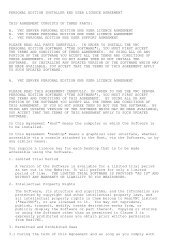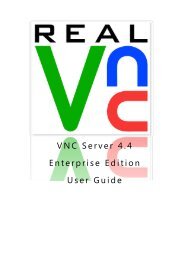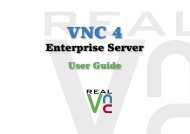VNC User Guide - RealVNC
VNC User Guide - RealVNC
VNC User Guide - RealVNC
You also want an ePaper? Increase the reach of your titles
YUMPU automatically turns print PDFs into web optimized ePapers that Google loves.
Appendix A: Saving Connections<br />
Saving connections to <strong>VNC</strong> Address Book<br />
You can save connections to <strong>VNC</strong> Address Book if you installed <strong>VNC</strong> on the client computer. For more<br />
information, see Setting up the client computer on page 12.<br />
Note: If <strong>VNC</strong> Address Book is not available, you can save connections to desktop icons. This is equally<br />
convenient but may be less secure. See Saving connections to desktop icons on page 131.<br />
When you save a connection, you can subsequently use <strong>VNC</strong> Address Book to connect to that host<br />
computer instead of <strong>VNC</strong> Viewer. This means you do not have to remember the network address of the host<br />
computer or the port number for <strong>VNC</strong> Server, nor a user name and password. In addition, <strong>VNC</strong> Address<br />
Book automatically recreates the <strong>VNC</strong> Viewer environment you chose for controlling that host computer last<br />
time, for example the scaling applied to the desktop, the encryption level, and the color quality.<br />
Note: Because <strong>VNC</strong> Address Book stores <strong>VNC</strong> Server authentication credentials, access to it is controlled<br />
by a master password. For more information, see Working with the master password on page 130.<br />
You can additionally use <strong>VNC</strong> Address Book to organize connections, configure the appearance and<br />
behavior of <strong>VNC</strong> Viewer for particular connections, and share connections with other <strong>VNC</strong> Viewer users.<br />
Saving the current connection<br />
If you are connected to a host computer, you can save the current connection to <strong>VNC</strong> Address Book at any<br />
time. To do this:<br />
1. Click the Save Connection <strong>VNC</strong> Viewer toolbar button. <strong>VNC</strong> Address Book opens. If you entered a<br />
password in order to connect to <strong>VNC</strong> Server, you are prompted to save it:<br />
Choose:<br />
— Don’t save <strong>VNC</strong> Server password in order to forget the password. You will need to enter it each<br />
time you use <strong>VNC</strong> Address Book to connect.<br />
— Save <strong>VNC</strong> Server password to save the password in obfuscated, though not encrypted, form. You<br />
will no longer need to remember the password. However, since the connection will not be protected<br />
by the <strong>VNC</strong> Address Book master password, any other user of your client computer will also be able<br />
to connect.<br />
— Encrypt <strong>VNC</strong> Server password to create a protected connection in which the password is both<br />
saved and encrypted. You will no longer need to remember it. You will, however, have to enter the<br />
122 <strong>VNC</strong> <strong>User</strong> <strong>Guide</strong>
















